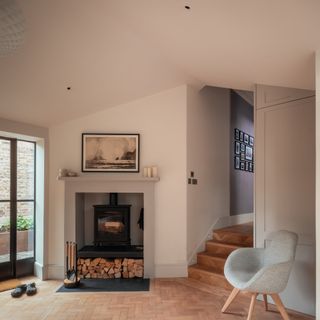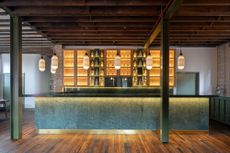Tilde House brings a listed London home up to contemporary, sustainable standards
Tilde House by Neil Dusheiko Architects blends Victorian elegance, sustainability and contemporary flair in north London’s historic Canonbury area

Tilde House's London neighbourhood, Canonbury in Islington, a conservation area since the 1960s, is a leafy district developed in the late 18th and early 19th centuries around a Tudor tower once part of an Elizabethan manor house. Its streets are lined with semi-detached mid-Victorian villas, many with big gardens and views of the New River park.
Among them, Tilde House is a Grade II-listed property, and has recently been remodelled and extended by Neil Dusheiko Architects, the practice behind such projects as north London's Tree View House , a light-filled mews house renovation in Bayswater, and the Sun Slice House family home in Cambridge .

Tour Tilde House by Neil Dusheiko Architects
With deep roots in the neighbourhood, the Canonbury Yard-based architects were the perfect candidates for a brief that required both a complete architectural transformation and the safeguarding of the property’s essence and heritage.
Built in the early 1840s, the villa is listed in part because of its elegant neo-classical detailing. This, of course, has been left untouched, which is why from the street you’d be forgiven for thinking that the property is no different from its period neighbours.

Step inside, though, and the interiors, once dark, dated and cramped, have been transformed into elegant spaces that lead to a new extension containing a bespoke kitchen. Replacing a shabby 1980s blockwork addition, the bespoke kitchen extension, built along the same foundation lines using recycled materials from the original, features a full-height glazed screen that opens onto the garden.
It is framed by dark saw-tooth bricks laid in a vertical basket-weave pattern to provide a tonal and textural contrast with the original house. This motif continues in the herringbone flooring and paving that flows through the kitchen and into the garden beyond, stitching old and new together.

Bringing a 178-year-old Grade II-listed house up to current standards was not without its challenges, especially in terms of technical aspects and structural repairs. Working with local conservation officers, the architects were allowed to remove exposed pipework throughout the house, and incorporate an ensuite bathroom beneath the listed staircase.
Wallpaper* Newsletter
Receive our daily digest of inspiration, escapism and design stories from around the world direct to your inbox.
‘Very much of the original house is kept intact and celebrated, so what we have added is quite hidden,’ explains Neil Dusheiko. ‘We were able to remove the existing rotten timber structure to the original single-storey outrigger and this allowed us to re-insulate and re-tile the existing roof.’

Historic homes are notoriously draughty, but the existing windows could not be upgraded, leading the team to install a secondary glazing. To improve the building’s thermal performance, they also sealed gaps around doors, windows and floorboards, and installed draft excluders on doors and windows.
‘Due to the absence of historic features in the dining space we were allowed to insulate the walls and so the linking space, containing the kitchen and dining room, is well insulated, reducing the need for too much heating,’ says Dusheiko.

Acting as a bridge between the original house, the contemporary extension and the garden, the dining room inspired a distinctive pleated roof design that folds and unfolds over the dining area and the kitchen.
Upstairs, new ensuite bathrooms are cleverly concealed behind crisp new joinery, painted in rich dark tones that change with shifting light throughout the day, and complementing retained and restored period features.
Léa Teuscher is a Sub-Editor at Wallpaper*. A former travel writer and production editor, she joined the magazine over a decade ago, and has been sprucing up copy and attempting to write clever headlines ever since. Having spent her childhood hopping between continents and cultures, she’s a fan of all things travel, art and architecture. She has written three Wallpaper* City Guides on Geneva, Strasbourg and Basel.
-
 Bali welcomes Tri Hita Karana Tower, a hybrid sound and vision centrepiece
Bali welcomes Tri Hita Karana Tower, a hybrid sound and vision centrepieceTri Hita Karana Tower is launching at Bali's Nuanu City; designed by Arthur Mamou-Mani, it’s a new hybrid art-AI architectural landmark for the island
By Ellie Stathaki Published
-
 Lego opens its first Superpower Studios at Paris’ La Gaîté Lyrique
Lego opens its first Superpower Studios at Paris’ La Gaîté LyriqueIn collaboration with Lego’s new Global Play Ambassadors, artists Aurélia Durand, Chen Fenwan and Ekow Nimako, and overseen by Colette co-founder Sarah Andelman, Paris is the site of the first Lego Superpower Studios
By Jonathan Bell Published
-
 ‘If kids grew up going to London Design Festival they would learn so much’: architect Shawn Adams
‘If kids grew up going to London Design Festival they would learn so much’: architect Shawn AdamsIn the first of our interviews with key figures lighting up the London Design Festival 2024, Shawn Adams, founder of POoR Collective, discusses the power of such events to encourage social change
By Ali Morris Published
-
 What to visit during London Open House 2024? We asked the experts
What to visit during London Open House 2024? We asked the expertsLost in choice? London Open House 2024 is as exciting as it is expansive. We asked some of our friends, all experts in their architectural field, for their tips on what to visit at this year's event
By Ellie Stathaki Published
-
 Thames Distillers raises our spirits with its new home and bar in London
Thames Distillers raises our spirits with its new home and bar in LondonFords bar at Thames Distillers' new home is a future London classic, designed by Transit Studio; we raise a toast to the gin maker
By Ellie Stathaki Published
-
 Wallpaper* Architects’ Directory 2024: meet the practices
Wallpaper* Architects’ Directory 2024: meet the practicesIn the Wallpaper* Architects Directory 2024, our latest guide to exciting, emerging practices from around the world, 20 young studios show off their projects and passion
By Ellie Stathaki Published
-
 Beacon House’s pink extension brightens up a Victorian London home refresh
Beacon House’s pink extension brightens up a Victorian London home refreshA pink extension in north London is part of the Beacon House project by Office S&M – the dramatic refresh of a Victorian home
By Ellie Stathaki Last updated
-
 Brown Urbanism's little triangle house is an ingenious urban infill
Brown Urbanism's little triangle house is an ingenious urban infillEmerging UK studio Brown Urbanism is part of the Wallpaper* Architects’ Directory 2024
By Ellie Stathaki Published
-
 Kasawoo's Greek red cabin retreat is perfect for minimalist escapes
Kasawoo's Greek red cabin retreat is perfect for minimalist escapesThe Wallpaper* Architects Directory 2024 welcomes Kasawoo, a young UK practice that draws on a new minimalist approach
By Ellie Stathaki Published
-
 A walk through The Brentford Project, a lesser-known west London neighbourhood
A walk through The Brentford Project, a lesser-known west London neighbourhoodThe Brentford Project in west London completes its first phase, offering modern residences, a wealth of public space and waterfront living
By Ellie Stathaki Published
-
 This clever Camden house renovation brings light, space and zen
This clever Camden house renovation brings light, space and zenEBBA architects’ Camden house renovation and double-height extension transform life in a London terraced home
By Bridget Downing Published